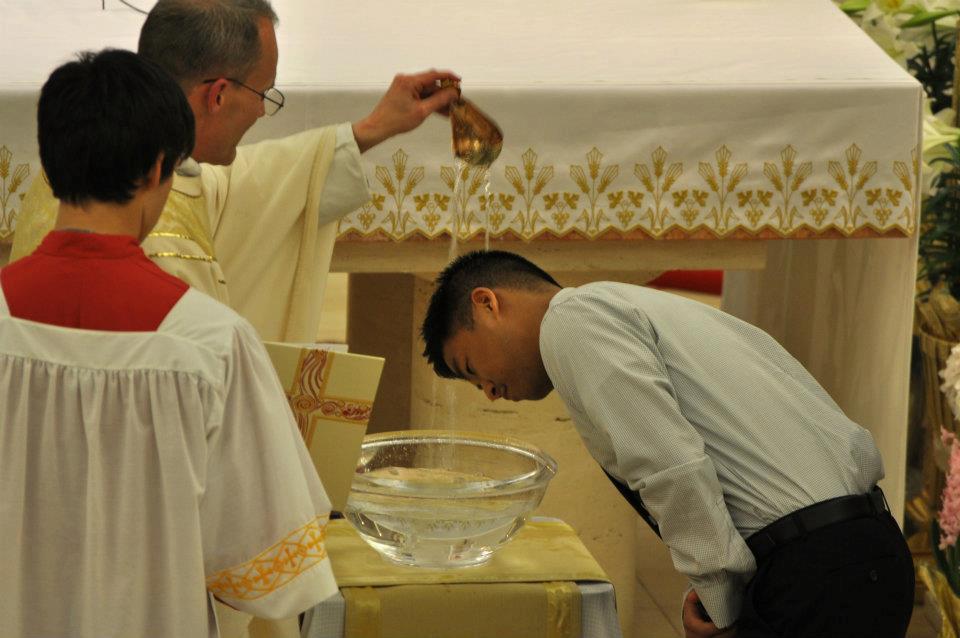 A very wise and holy priest of the Congregation of Holy Cross once told me, in a moment of challenging simplicity, that the secret to the spiritual life was “showing up.” I was at that time seeking something along the lines of Saul’s conversion experience on the road to Damascus so, like so many inheritors of good advice, I immediately disowned it. But upon reading a recent study by David Yamane on the results of RCIA implementation in over 30 parishes across the diocese of Ft. Wayne/South Bend, I was forced to revisit the priest’s advice. Yamane’s study employs complex sociological research methods and models (and I would suggest anyone interested in the details should read the study and also see Laura Taylor’s excellent post about it). For the purposes of this post, I would like to highlight Yamane’s finding that “the extent of RCIA implementation is the key factor driving this model…If we consider the total effect of implementation (its direct effect plus its indirect effect through rating), we see it is over three times as large as the effect of rating” (413-414). In other words, a more fully implemented RCIA program (including regular practice of the Rite of Dismissal, a longer period of mystagogy, and a continuous precatechumenate) is more effective at facilitating involvement in parish life than the participant’s personal assessment of the RCIA program.
A very wise and holy priest of the Congregation of Holy Cross once told me, in a moment of challenging simplicity, that the secret to the spiritual life was “showing up.” I was at that time seeking something along the lines of Saul’s conversion experience on the road to Damascus so, like so many inheritors of good advice, I immediately disowned it. But upon reading a recent study by David Yamane on the results of RCIA implementation in over 30 parishes across the diocese of Ft. Wayne/South Bend, I was forced to revisit the priest’s advice. Yamane’s study employs complex sociological research methods and models (and I would suggest anyone interested in the details should read the study and also see Laura Taylor’s excellent post about it). For the purposes of this post, I would like to highlight Yamane’s finding that “the extent of RCIA implementation is the key factor driving this model…If we consider the total effect of implementation (its direct effect plus its indirect effect through rating), we see it is over three times as large as the effect of rating” (413-414). In other words, a more fully implemented RCIA program (including regular practice of the Rite of Dismissal, a longer period of mystagogy, and a continuous precatechumenate) is more effective at facilitating involvement in parish life than the participant’s personal assessment of the RCIA program.
The study demonstrates that people asked to do more end up becoming more involved in parish life. This points back to the ancient understanding of the virtues as habits. According to Yamane’s conclusions, establishing firm habits of commitment appears to count more than the subjective experience of the RCIA program. First and foremost, I sincerely hope that Yamane’s study helps to ease some RCIA directors’ fears and anxieties about asking too much of their participants’ time and attempting to make every presentation comedic or every retreat transformative. Clearly, we all must do our best but it is equally important to remember that the quest for quality goes hand in hand with the humility of quantity – asking people to develop the virtue of commitment. Realistically, it is training in this virtue that is perhaps best for men and women entering a community that is not immune to serious frustrations. Requiring RCIA participants to attend groups and services regularly might be just the thing to appropriately cultivate perseverance when faced with such frustrations. RCIA, if it is effectively incorporated and made into an integral part of the whole parish’s life, may just remind all Catholics that the key to the spiritual life is still “showing up.”
But the conclusion to Yamane’s study reveals, at first glance, another more troubling insight: the spiritual practices of converts underwent a very minimal decline when measured a year after they began the RCIA process. On one hand, for many people conversion is an enormously taxing endeavor and a slight slackening of spiritual practices is somewhat to be expected after such an exertion. Yet on the other hand, that decrease is deeply worrisome given the bishops’ expressed aims for RCIA, as Yamane appropriately notes. Ultimately, the challenge with this insight lies not with actual results of RCIA programs, but with translating from sociology to theology. In his methodology, Yamane distinguishes between “ecclesial involvement” and “spiritual practice” where the latter includes private prayer and reading the Bible and it was this that underwent the decline. However, I think that most parish administrators and ministers would include attending Mass and participating in spiritual groups (Bible study, prayer group, faith sharing group, etc.) to be more appropriately listed under “spiritual practice” rather than “ecclesial involvement”, where it is currently listed. Those practices are, of course, ecclesial and attending Mass is the most ecclesial practice in which one can engage. Nevertheless, it is slightly confusing to find in the study that the “spiritual practices” of converts slightly decreased when, in fact, it was their private prayer and reading of the Bible that decreased slightly. This is undoubtedly troublesome but, for a group of people intensely formed in the RCIA community, isn’t it more realistic to expect that their “spiritual practices” will shift towards more communal practices? This is only a point of clarification – Yamane’s study is certainly helpful and it will be fruitful for RCIA directors to note that it is just as important to facilitate increased personal prayer as it is to encourage “ecclesial involvement”.
I also feel I would be remiss to not take this opportunity to expand out the categories that Yamane employs in his very useful study. Attending Mass, private prayer, and parish involvement (in both spiritual groups and social justice ministries) are all laudable metrics of a successful RCIA program. However, these categories do seem to employ traditionally Catholic understandings of involvement that aren’t as immediately intelligible to our brothers and sisters coming from Evangelical and mainline Protestant backgrounds. These RCIA participants often struggle to transition from very sociable congregations to the oftentimes more…stoic feel of many Catholic parishes. There are a wide variety of reasons for conversion and no single program can likely address all deficiencies. But it does seem to me that living a truly Christian life in an individualistic age requires a greater communal identity to withstand the onslaught of economic, social, and cultural pressures that encourage the satisfaction of the self over the group. Catholic parishes would do well to take note and learn from congregations that consciously and actively attempt to cultivate not just a worship group but a living community that engages on Sunday and throughout the week in various social settings.
This isn’t just of importance for our converts either, it is deeply needed for Catholics today. While solid catechesis and introductions to the sacraments are crucial aspects of any RCIA program, these are merely lenses of instruction that nevertheless still require the light of faith to illuminate them. Unless the RCIA process is integrated and contextualized within a larger Church community that seeks to mirror the self-giving of Jesus Christ in charity and trust, even the best RCIA programs will come up short. For the teachings of the Catholic Church, particularly the most difficult ones on transubstantiation and sexual morality, only begin to make sense within a community that lives with and for each other. It is easier to grasp that Jesus Christ could be so humble to give Himself in the fellowship of bread and wine when surrounded by a community readily willing to give itself in time and charity. This living faith provides the proper template onto which the more difficult Church teachings can properly “fit”; only in such a context do they become the living words of the Christian grammar of self-giving. In other words – only a community embodying this self-giving can facilitate the self-giving asked by the Church of its members. Even simple things like monthly potlucks, weekend family movie nights in the summer, programs to effectively match up parishioner needs to other parishioners’ skills and services, etc. can all help towards bringing this vision of self-giving to realization.
I am sure that many parish ministers and volunteers will hardly be excited to read yet another academic rant on parish involvement. But I have observed that RCIA gets current Catholics excited about sharing their faith and enthused to see other people embracing it. It was stunning for me to see the reactions from other Catholics after the Easter vigil – strangers eagerly approached the new members to congratulate and welcome them. There was an infectious enthusiasm in celebrating the truth and triumph of Christ, in being united in that joy. I think that RCIA is an often underutilized opportunity to channel that already-existing excitement and enthusiasm of “old” members for “new” members into the life of the whole congregation. Potlucks for new RCIA participants, taking participants to various meetings of organizations within the parish, offering the chance for participants to be greeters at Sunday masses, etc. are all great chances to integrate new members and to reinvigorate “old” members. It is my hope that Yamane’s study can help continue to encourage the Catholic community to develop a robust sense of communal identity and to incorporate more and more of RCIA into parish life in order to demonstrate what the Church truly is: a home for all believers.

I agree with what Michael says, especially about the many opportunities a parish can offer catechumens for greater involvement and hopefully in the process gain a greater communal sensibility. All of the ideas to foster greater community among initiates and faithful are welcome. But as I said in my earlier comment, some parishes that already have this greater communal reality can find what the RCIA requires an obstacle to initiation. Community is an important factor and it seems that city parishes, at least in Detroit, have a greater experience of community than do suburban parishes and consequently the RCIA needs to be adapted (reduced, stripped down if you will) in some parishes (city) and perhaps not in others (suburban).
A very nice article. I just wish the author would avoid using the term “convert” as a generic term. The term “convert” is only used for non-Christians being initiated.